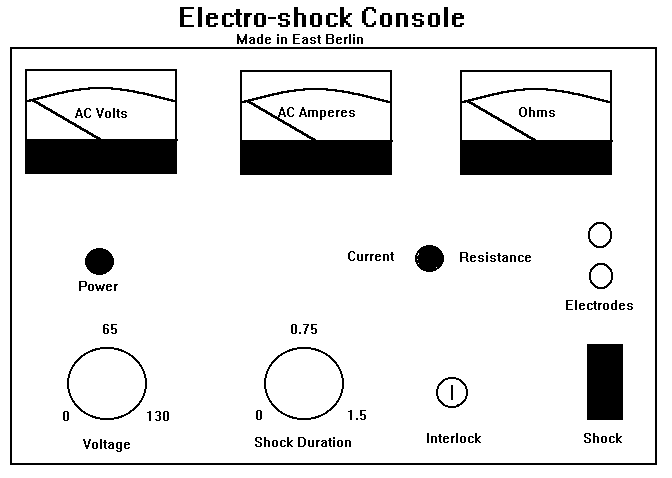Technical Information about the Shock Shop
I got the following information from the edition of One Flew Over the Cuckoo's Nest that has all the articles in the back of the book about various aspects of mental institutions. Some is also based on my own experiences, but unlike Ken Kesey, I have never had the experience of having a shock treatment. Therefore, my observations are from the view of staff rather than that of a patient. First, here's a picture of a shock treatment console based from what I remember of what they were like.

Shock Treatment Procedure
- Patient is dragged screaming and kicking into the treatment room and they close the heavy metal door (gotcha)

- Patient is strapped to the treatment table
- Patient is knocked out with sodium pentothol and given a muscle relaxant

- Electrode cream (conductant) and electrodes are applied to patient
- Resistance reading taken of patient and voltage and shock duration set
- Mouth guard is inserted into patient's mouth
- Safety key turned, button guard raised and button pressed to give the treatment
- Impact of treatment causes the patient to shoot out of the treatment room on a Gurney,
 which rounds the corner on two wheels and races down the hall still smoking (according to Ken Kesey)
which rounds the corner on two wheels and races down the hall still smoking (according to Ken Kesey)
How the Electro-Shock Therapy Console Works
The shock console consists of the three meters, a variable transformer that is used to adjust the voltage and an automatic timer that controls the duration (length) of the shock. The console operates on standard 120 volt 60 cycle alternating current, but must be supplied through a constant voltage transformer to protect the patient from power surges. It should also be on a ground fault circuit
interrupter for the same reason.
The amount of voltage used for treatment ranges from 70 to 130 volts at a duration between 0.1 and 1.5 seconds. After the electrodes are placed on the patient, a resistance reading is taken and Ohm's Law is used to figure out how much voltage should be given. Once this is determined, the voltage and shock duration are set. After this is done, the safety key is turned, the button guard is lifted and the button is pressed to give the treatment.
Shock treatments cause apnea, a temporary loss of breathing. Artificial respiration is sometime used as a safety measure. The patient remains unconscious for about five minutes after the treatment. The shock treatments also cause a temporary loss of memory. If the shock treatments don't get the desired results in a reasonable time, they usually try a lobotomy next.
Back to the little red capsules


Copyright © 1995-1997, Colin Pringle
shock.htm

